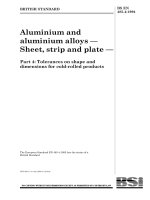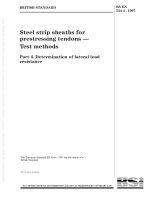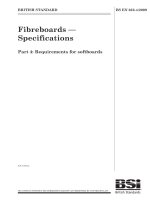Bsi bs en 61290 4 2 2011
Bạn đang xem bản rút gọn của tài liệu. Xem và tải ngay bản đầy đủ của tài liệu tại đây (1.13 MB, 24 trang )
BS EN 61290-4-2:2011
BSI Standards Publication
Optical amplifiers — Test
methods
Part 4-2: Gain transient parameters —
Broadband source method
NO COPYING WITHOUT BSI PERMISSION EXCEPT AS PERMITTED BY COPYRIGHT LAW
raising standards worldwide™
BS EN 61290-4-2:2011
BRITISH STANDARD
National foreword
This British Standard is the UK implementation of EN
61290-4-2:2011. It is identical to IEC 61290-4-2:2011.
The UK participation in its preparation was entrusted to Technical
Committee GEL/86/3, Fibre optic systems and active devices.
A list of organizations represented on this committee can be
obtained on request to its secretary.
This publication does not purport to include all the necessary
provisions of a contract. Users are responsible for its correct
application.
© BSI 2011
ISBN 978 0 580 68184 4
ICS 33.180.30
Compliance with a British Standard cannot confer immunity from
legal obligations.
This British Standard was published under the authority of the
Standards Policy and Strategy Committee on 31 October 2011.
Amendments issued since publication
Date
Text affected
BS EN 61290-4-2:2011
EUROPEAN STANDARD
EN 61290-4-2
NORME EUROPÉENNE
EUROPÄISCHE NORM
September 2011
ICS 33.180.30
English version
Optical amplifiers Test methods Part 4-2: Gain transient parameters Broadband source method
(IEC 61290-4-2:2011)
Amplificateurs optiques Méthodes d’essai Partie 4-2: Paramètres de gain
transitoire Méthode par source large bande
(CEI 61290-4-2:2011)
Lichtwellenleiter-Verstärker Prüfverfahren Teil 4-2: Transiente Verstärkerparameter Breitbandquellen Verfahren
(IEC 61290-4-2:2011)
This European Standard was approved by CENELEC on 2011-08-17. CENELEC members are bound to comply
with the CEN/CENELEC Internal Regulations which stipulate the conditions for giving this European Standard
the status of a national standard without any alteration.
Up-to-date lists and bibliographical references concerning such national standards may be obtained on
application to the Central Secretariat or to any CENELEC member.
This European Standard exists in three official versions (English, French, German). A version in any other
language made by translation under the responsibility of a CENELEC member into its own language and notified
to the Central Secretariat has the same status as the official versions.
CENELEC members are the national electrotechnical committees of Austria, Belgium, Bulgaria, Croatia, Cyprus,
the Czech Republic, Denmark, Estonia, Finland, France, Germany, Greece, Hungary, Iceland, Ireland, Italy,
Latvia, Lithuania, Luxembourg, Malta, the Netherlands, Norway, Poland, Portugal, Romania, Slovakia, Slovenia,
Spain, Sweden, Switzerland and the United Kingdom.
CENELEC
European Committee for Electrotechnical Standardization
Comité Européen de Normalisation Electrotechnique
Europäisches Komitee für Elektrotechnische Normung
Management Centre: Avenue Marnix 17, B - 1000 Brussels
© 2011 CENELEC -
All rights of exploitation in any form and by any means reserved worldwide for CENELEC members.
Ref. No. EN 61290-4-2:2011 E
BS EN 61290-4-2:2011
EN 61290-4-2:2011
-2-
Foreword
The text of document 86C/957/CDV, future edition 1 of IEC 61290-4-2, prepared by SC 86C, "Fibre optic
systems and active devices", of IEC TC 86, "Fibre optics", was submitted to the IEC-CENELEC parallel
vote and approved by CENELEC as EN 61290-4-2:2011.
The following dates are fixed:
•
•
latest date by which the document has
to be implemented at national level by
publication of an identical national
standard or by endorsement
latest date by which the national
standards conflicting with the
document have to be withdrawn
(dop)
2012-05-17
(dow)
2014-08-17
This standard is to be used in conjunction with EN 61291-1.
Attention is drawn to the possibility that some of the elements of this document may be the subject of
patent rights. CENELEC [and/or CEN] shall not be held responsible for identifying any or all such patent
rights.
Endorsement notice
The text of the International Standard IEC 61290-4-2:2011 was approved by CENELEC as a European
Standard without any modification.
In the official version, for Bibliography, the following notes have to be added for the standards indicated:
IEC 61290-1-1
NOTE Harmonized as EN 61290-1-1.
IEC 61290-1-2
NOTE Harmonized as EN 61290-1-2.
IEC 61290-1-3
NOTE Harmonized as EN 61290-1-3.
BS EN 61290-4-2:2011
-3-
EN 61290-4-2:2011
Annex ZA
(normative)
Normative references to international publications
with their corresponding European publications
The following referenced documents are indispensable for the application of this document. For dated
references, only the edition cited applies. For undated references, the latest edition of the referenced
document (including any amendments) applies.
NOTE When an international publication has been modified by common modifications, indicated by (mod), the relevant EN/HD
applies.
Publication
Year
Title
EN/HD
Year
IEC 61290-4-1
2011
Optical amplifiers - Test methods Part 4-1: Gain transient parameters - twowavelength method
EN 61290-4-1
2011
IEC 61291-1
-
Optical amplifiers Part 1: Generic specification
EN 61291-1
-
BS EN 61290-4-2:2011
–2–
61290-4-2 © IEC:2011
CONTENTS
FOREWORD ........................................................................................................................... 3
INTRODUCTION ..................................................................................................................... 5
1
Scope and object .............................................................................................................. 6
2
Normative references........................................................................................................ 6
3
Terms, definitions and abbreviations ................................................................................. 6
4
3.1 General ................................................................................................................... 6
3.2 Terms and definitions .............................................................................................. 9
3.3 Abbreviated terms ................................................................................................. 10
Apparatus ....................................................................................................................... 10
5
Test sample .................................................................................................................... 12
6
Procedure ....................................................................................................................... 12
7
Calculations .................................................................................................................... 13
8
Test results .................................................................................................................... 14
Annex A (informative) Comparison between two-wavelength method and broadband
method ................................................................................................................................. 15
Bibliography .......................................................................................................................... 17
Figure 1 – Definitions of rise and fall times for (a) a channel addition event, and (b) a
channel removal event ............................................................................................................ 7
Figure 2 – OFA transient gain response for (a) a channel removal event, and (b) a
channel addition event ............................................................................................................ 8
Figure 3 – Transient measurement test set-up for broadband source method ......................... 11
Figure A.1 – Effect of non-flat gain spectrum on gain offset ................................................... 15
Figure A.2 – Different transient suppression response for different types of saturating
signals .................................................................................................................................. 16
Table 1 – Examples of “add” and “drop” scenarios for transient control measurement ............ 13
Table 2 – Typical results of transient control measurement for a C-Band EDFA ..................... 14
BS EN 61290-4-2:2011
61290-4-2 © IEC:2011
–3–
INTERNATIONAL ELECTROTECHNICAL COMMISSION
____________
OPTICAL AMPLIFIERS –
TEST METHODS –
Part 4-2: Gain transient parameters –
Broadband source method
FOREWORD
1) The International Electrotechnical Commission (IEC) is a worldwide organization for standardization comprising
all national electrotechnical committees (IEC National Committees). The object of IEC is to promote
international co-operation on all questions concerning standardization in the electrical and electronic fields. To
this end and in addition to other activities, IEC publishes International Standards, Technical Specifications,
Technical Reports, Publicly Available Specifications (PAS) and Guides (hereafter referred to as “IEC
Publication(s)”). Their preparation is entrusted to technical committees; any IEC National Committee interested
in the subject dealt with may participate in this preparatory work. International, governmental and nongovernmental organizations liaising with the IEC also participate in this preparation. IEC collaborates closely
with the International Organization for Standardization (ISO) in accordance with conditions determined by
agreement between the two organizations.
2) The formal decisions or agreements of IEC on technical matters express, as nearly as possible, an international
consensus of opinion on the relevant subjects since each technical committee has representation from all
interested IEC National Committees.
3) IEC Publications have the form of recommendations for international use and are accepted by IEC National
Committees in that sense. While all reasonable efforts are made to ensure that the technical content of IEC
Publications is accurate, IEC cannot be held responsible for the way in which they are used or for any
misinterpretation by any end user.
4) In order to promote international uniformity, IEC National Committees undertake to apply IEC Publications
transparently to the maximum extent possible in their national and regional publications. Any divergence
between any IEC Publication and the corresponding national or regional publication shall be clearly indicated in
the latter.
5) IEC itself does not provide any attestation of conformity. Independent certification bodies provide conformity
assessment services and, in some areas, access to IEC marks of conformity. IEC is not responsible for any
services carried out by independent certification bodies.
6) All users should ensure that they have the latest edition of this publication.
7) No liability shall attach to IEC or its directors, employees, servants or agents including individual experts and
members of its technical committees and IEC National Committees for any personal injury, property damage or
other damage of any nature whatsoever, whether direct or indirect, or for costs (including legal fees) and
expenses arising out of the publication, use of, or reliance upon, this IEC Publication or any other IEC
Publications.
8) Attention is drawn to the Normative references cited in this publication. Use of the referenced publications is
indispensable for the correct application of this publication.
9) Attention is drawn to the possibility that some of the elements of this IEC Publication may be the subject of
patent rights. IEC shall not be held responsible for identifying any or all such patent rights.
International Standard IEC 61290-4-2 has been prepared by subcommittee 86C: Fibre optic
systems and active devices, of IEC technical committee 86: Fibre optics.
This standard shall be used in conjunction with IEC 61291-1. It was established on the basis of
the second (2006) edition of that standard.
Future standards in this series will carry the new general title as cited above. Titles of existing
standards in this series will be updated at the time of the next edition.
BS EN 61290-4-2:2011
–4–
61290-4-2 © IEC:2011
The text of this standard is based on the following documents:
CDV
Report on voting
86C/957/CDV
86C/991/RVC
Full information on the voting for the approval of this standard can be found in the report on
voting indicated in the above table.
This publication has been drafted in accordance with the ISO/IEC Directives, Part 2.
A list of all parts of the IEC 61290 series, published under the general title Optical amplifiers –
Test methods can be found on the IEC website.
The committee has decided that the contents of this publication will remain unchanged until the
stability date indicated on the IEC web site under "" in the data related to
the specific publication. At this date, the publication will be
•
•
•
•
reconfirmed,
withdrawn,
replaced by a revised edition, or
amended.
IMPORTANT – The 'colour inside' logo on the cover page of this publication indicates
that it contains colours which are considered to be useful for the correct understanding
of its contents. Users should therefore print this document using a colour printer.
BS EN 61290-4-2:2011
61290-4-2 © IEC:2011
–5–
INTRODUCTION
This part of IEC 61290-4 is devoted to the subject of optical amplifiers. The technology of
optical amplifiers is quite new and still emerging; hence amendments and new editions to this
standard can be expected.
Each abbreviation introduced in this standard is explained in the text at least the first time it
appears. However, for an easier understanding of the whole text, a list of all abbreviations used
in this standard is given in 3.3.
BS EN 61290-4-2:2011
–6–
61290-4-2 © IEC:2011
OPTICAL AMPLIFIERS –
TEST METHODS –
Part 4-2: Gain transient parameters –
Broadband source method
1
Scope and object
This part of IEC 61290-4 applies to optical amplifiers (OAs) and optically amplified elementary
sub-systems. More specifically, it applies to OAs using active fibres (optical fibre amplifiers,
OFAs) containing rare-earth dopants, such as erbium doped fibre amplifiers (EDFAs), presently
commercially available, as indicated in IEC 61291-1.
The object of this part of IEC 61290-4 is to establish uniform requirements for accurate and
reliable measurements, by means of the broadband source method, of the transient response of
OFAs to dynamic changes in their input power, as defined in IEC 61290-4-1:2011.
The broadband source method is different from the two-wavelength method described in
IEC 61290-4-1:– in that the saturating signal is not located at a single wavelength, but is rather
spread out across the entire specified DWDM transmission band of the OFA-under-test (e.g. the
C-Band, 1 525 nm to 1 565 nm). Thus, this method may be relevant to the characterization of
transient events where the DWDM signals that are added or dropped are more or less uniformly
spread across the transmission band. The difference between the two measurement methods is
discussed in more detail in Annex A.
2
Normative references
The following referenced documents are indispensable for the application of this document. For
dated references, only the edition cited applies. For undated references, the latest edition of
the referenced document (including any amendments) applies.
IEC 61290-4-1:2011, Optical amplifiers – Test methods – Part 4-1: Gain transient parameters –
Two wavelength method
IEC 61291-1, Optical fibre amplifiers – Part 1: Generic specification
3
3.1
Terms, definitions and abbreviations
General
When the input power to an OFA operating in saturation changes sharply, the gain of the
amplifier will typically exhibit a transient response before settling back into the required gain.
This response is dictated both by the optical characteristics of the active fibre within the OFA,
as well as the performance of the automatic gain control (AGC) mechanism.
Since a change in input power typically occurs when part of the DWDM channels within the
specified transmission band are dropped or added, definitions are provided that describe a
dynamic event leading to a transient response. Rise and fall time definitions are shown in
Figure 1.
BS EN 61290-4-2:2011
Input power to EDFA
(linear a.u.)
61290-4-2 © IEC:2011
–7–
100 %
of change
90 %
of change
10 %
of change
Rise
time
Channel
addition start
Channel
addition end
Input power to EDFA
(linear a.u.)
(a)
Time
IEC
1582/11
10 %
of change
90 %
of change
100 %
of change
Fall
time
Time
Channel
removal start
Channel
removal end
(b)
IEC
1583/11
Figure 1 – Definitions of rise and fall times for (a) a channel addition event,
and (b) a channel removal event
The parameters generally used to characterize the transient gain behaviour of a gain controlled
OFA for the case of channel addition/removal are defined in Figure 2. Figure 2(a) specifically
represents the time dependence of the gain of one of the surviving channels when channels
are removed. Likewise the transient gain behaviour of a pre-existing channel for the case when
channels are added is shown in Figure 2(b). The main transient parameters are: transient gain
BS EN 61290-4-2:2011
–8–
61290-4-2 © IEC:2011
response time constant (setting time), gain offset, transient net gain overshoot, and transient
net gain undershoot. The transient gain overshoot and undershoot are particularly critical to
carriers and network equipment manufacturers (NEMs) given that the speed and amplitude of
gain fluctuations compound through the network as the optical signal passes through an
increasing number of cascaded amplifiers. Properly designed optical amplifiers have very small
values for these transient parameters .
Gain (dB)
Net gain
overshoot
Gain
overshoot
Gain
stability
Final
gain
Gain offset
Initial
gain
Net gain
undershoot
Gain
undershoot
Transient gain response time
constant (settling time)
Time
(a)
Gain (dB)
Net gain
Overshoot
IEC
1584/11
Gain
overshoot
Initial
gain
Gain offset
Gain
undershoot
Gain
stability
Final
gain
Net gain
undershoot
Transient gain response time
constant (settling time)
(b)
Time
IEC
Figure 2 – OFA transient gain response for (a) a channel removal event,
and (b) a channel addition event
1585/11
BS EN 61290-4-2:2011
61290-4-2 © IEC:2011
3.2
–9–
Terms and definitions
For the purposes of this document, the following terms, definitions and abbreviations apply.
3.2.1
surviving (pre-existing) signal
optical signal that remains (exists) after (before) a drop (add) event
3.2.2
saturating signal
optical signal that is switched off (on), thus triggering the drop (add) event
3.2.3
drop (add) level (dB)
amount in dB by which the input power decreases (increases) due to dropping (adding) of
channels
3.2.4
add rise time
time it takes for the input power to rise from 10 % to 90 % of the total difference between the
initial and final input power levels during an add event (see Figure 1a)
3.2.5
drop fall time
time it takes for the input power to fall from 10 % to 90 % of the total difference between the
initial and final input power levels during a drop event (see Figure 1b)
3.2.6
initial gain
gain of the surviving (pre-existing) channel before a drop (add) event
3.2.7
final gain
steady state gain of the surviving (pre-existing) channel a very long time (i.e. once the gain has
stabilized) after a drop (add) event
3.2.8
gain offset
change in dB of the gain between initial and final state, defined as final gain – initial gain
NOTE
Gain offset may be positive or negative for both channel addition and removal events.
3.2.9
gain stability
specified peak-to-peak gain fluctuations of the OFA under steady state conditions (i.e. not in
response to a transient event)
3.2.10
transient gain response time constant (settling time)
amount of time required to bring the gain of the surviving (pre-existing) channel to the final gain
NOTE 1 This parameter is the measured time from the beginning of the drop (add) event that created the transient
gain response, to the time at which the surviving (pre-existing) channel gain first enters within the gain stability
band centred on the final gain.
NOTE 2
Hereon this will also be referred to as settling time.
BS EN 61290-4-2:2011
– 10 –
61290-4-2 © IEC:2011
3.2.11
transient gain overshoot
difference in dB between the maximum surviving (pre-existing) channel gain reached during the
OFA transient response to a drop (add) event, and the lowest of either the initial gain and final
gain
NOTE
Hereon this will also be referred to as gain overshoot.
3.2.12
transient net gain overshoot
difference in dB between the maximum surviving (pre-existing) channel gain reached during the
OFA transient response to a drop (add) event, and the highest of either the initial gain and final
gain
NOTE 1 The transient net gain overshoot is just the transient gain overshoot minus the gain offset, and represents
the actual transient response not related to the shift of the amplifier from the initial steady state condition to the
final steady state condition.
NOTE 2
Hereon this will also be referred to as net gain overshoot.
3.2.13
transient gain undershoot
difference in dB between the minimum surviving (pre-existing) channel gain reached during the
OFA transient response to a drop (add) event, and the highest of either the initial gain and final
gain
NOTE
Hereon this will also be referred to as gain undershoot.
3.2.14
transient net gain undershoot
difference in dB between the minimum surviving (pre-existing) channel gain reached during the
OFA transient response to a drop (add) event, and the lowest of either the initial gain and final
gain
NOTE 1 The transient net gain undershoot is just the transient gain undershoot minus the gain offset, and
represents the actual transient response not related to the shift of the amplifier from the initial steady state
condition to the final steady state condition.
NOTE 2
3.3
Hereon this will also be referred to as net gain undershoot.
Abbreviated terms
AGC
automatic gain control
DFB
distributed feedback
DWDM
dense wavelength division multiplexing
EDFA
erbium-doped fibre amplifier
NEM
network equipment manufacturer
OA
optical amplifier
OFA
optical fibre amplifier
SHB
spectral hole burning
VOA
variable optical attenuator
WDM
wavelength division multiplexing
4
Apparatus
Figure 3 shows a generic setup to characterize the transient response properties of OFAs
using the broadband source method.
BS EN 61290-4-2:2011
61290-4-2 © IEC:2011
Laser
source
– 11 –
VOA1
Optical
coupler
Broadband
source
VOA2
Block
filter
OFA
under
test
Pass
filter
Optical
modulator
Detector
Pulse generator
Trigger
Oscilloscope
IEC
1586/11
Figure 3 – Transient measurement test set-up for broadband source method
The test equipment listed below, with the required characteristics, is needed.
a) A laser source for supplying the surviving signal, with the following characteristics
1) Ability to support the range of surviving signal wavelengths for which the OFA under
test is to be tested. This could be provided for example by a tunable laser, or a bank of
distributed feedback (DFB) lasers
2) An achievable average output power such that at the input to the OFA under test the
power will be above the maximum specified input power of the OFA
b) A broadband source for supplying the saturating signal, with the following characteristics
1) At least 95 % of the output power should be contained within the specified transmission
band of the OFA under test
2) A variation of not more than 1dB peak-to-peak of the power level across the specified
transmission band of the OFA under test
3) An achievable output power such that at the input to the OFA under test the power will
be above the maximum specified input power of the OFA
c) VOA1 – A variable optical attenuator (VOA) with a dynamic range sufficient to support the
required range of surviving signal levels at which the OFA under test is to be tested
NOTE 1 If the output power of the laser source can be varied over the required dynamic range, then VOA1
may not be needed.
d) VOA2 – A VOA with a dynamic range sufficient to support the required range of saturating
signal powers (dictated by the sum of the surviving signal levels and drop level) at which
the OFA under test is to be tested.
NOTE 2 If the output power of the broadband source can be varied over the required dynamic range, then
VOA2 may not be needed.
e) Block filter – A filter designed to block the broadband signal in the vicinity of the surviving
signal wavelength, with the following characteristics
1) Ability to support the range of surviving signal wavelengths for which the OFA under
test is to be tested. This could be provided for example by a tunable filter, or a series of
discrete filters.
2) Uniform insertion loss to within 0,5 dB over the entire specified transmission band of
the OFA under test except in a range of ±125 GHz of the surviving signal wavelength.
3) Attenuation of at least 15 dB over the uniform Insertion Loss in a range of ±75 GHz of
the surviving signal wavelength
f)
Optical modulator to switch the saturating signal “on” and “off”, with the following
characteristics
BS EN 61290-4-2:2011
– 12 –
61290-4-2 © IEC:2011
1) Extinction ratio at least 5 dB higher than the maximum drop level for which the OFA
under test is to be tested
2) Switching time fast enough to support the fastest drop time for which the OFA under
test is to be tested
g) Optical coupler – Any optical coupler selected to support requirements a)2) and b)3) above
h) Pass filter – A filter designed to pass only the surviving signal wavelength, with the
following characteristics
1) Ability to support the range of surviving signal wavelengths for which the OFA-undertest is to be tested. This could be provided for example by a tunable filter, or a series of
discrete filters
2) 1-dB passband of at least ±20 GHz centered around the surviving signal wavelength
3) At least 20 dB attenuation level below the minimum insertion loss across the entire
specified transmission band of the OFA under test except within a range of ±100 GHz
centered around the surviving signal wavelength
i)
Detector – to detect the filtered output of the OFA under test, with the following
characteristics
1) A sufficiently wide bandwidth to support the fastest drop time for which the OFA is to be
tested
2) A linear response within a ±5 dB range of all surviving signal levels for which the OFA
under test is to be tested
j)
Oscilloscope – to measure the transient response of the filtered output of the OFA under
test, with a sufficiently wide bandwidth to support the fastest drop time for which the OFA is
to be tested
k) Pulse generator – To generate the “on”-“off” signal to the optical modulator, with a pulse
width short enough to support the fastest drop time for which the OFA under test is to be
tested
5
Test sample
The OFA shall operate at nominal operating conditions. If the OFA is likely to cause laser
oscillations due to unwanted reflections, optical isolators should be used to bracket the OFA
under test. This will minimize signal instability and measurement inaccuracy.
6
Procedure
In the setup shown, the input signal power to the OFA under test is the combination of a
discrete wavelength representing the surviving signal, and a broadband source representing a
saturating signal. The power of each of these two sources can be adjusted via the appropriate
VOA to achieve the desired power ratio at the input to the OFA necessary to simulate the add
and drop events to be tested. The broadband source is filtered by a block filter such that the
radiation in the vicinity of the surviving signal wavelength is always well below the surviving
signal level. Furthermore, the broadband source is turned “on” and “off” via the pulse generator
driving the optical modulator, thus simulating add and drop event.
The output of the OFA under test is filtered such that only the surviving signal power is
detected by the detector and the oscilloscope (taking into account that radiation from the
broadband source in the vicinity of the surviving signal wavelength was already filtered by the
block filter). Utilizing the pulse generator as a trigger, the oscilloscope can be configured to
show the transient response of the power of the surviving signal after both drop and add events.
Measurement of the various transient response parameters from the oscilloscope display is
described in detail in IEC 61290-4-1:–.
To perform a single transient measurement, the following steps should be followed
BS EN 61290-4-2:2011
61290-4-2 © IEC:2011
– 13 –
a) Set the wavelength of the laser source, block filter and pass filter according to the surviving
signal wavelength to be tested
b) Set the gain of the OFA under test to the required operating gain for the measurement. The
gain can be measured either using an internal calibrated gain measurement function of the
OFA, or directly according to one of the following standards: IEC 61290-1-1, IEC 61290-1-2,
IEC 61290-1-3
c) Set the power levels of the laser source and broadband source (using the VOAs and with
the modulator at the “on” position) such that the following conditions are satisfied at the
input to the OFA under test
1) The total input power is equal to the required operating input power for the
measurement
2) The difference between the total input power and the laser source power is drop level
NOTE The input power to the OFA under test can typically be measured using an internal detector within the
OFA module especially calibrated for this purpose. Should such a detector not be available, then a calibrated
optical power meter can be connected in place for the OFA under test for the purpose of measuring the input
power.
d) Activate the pulse generator and set the fall and rise times of the pulses to the required
drop and add times to be tested. Using the oscilloscope, verify that the measured fall and
rise times (10 % to 90 %) are between 0,5 and 1 times the required drop and add times to
be tested
e) Set the trigger function of the oscilloscope to display a drop event, and record the display.
Then set the trigger function to display an add event and record the display (see
IEC 61290-4-1:–)
Several transient control measurements can be performed, according to the operating
conditions and specifications that are provided. Measurements may also be taken for various
“add” and “drop” scenarios as shown in Table 1. These measurements are typically performed
over a broad range of input power levels.
Table 1 – Examples of “add” and “drop” scenarios for transient control measurement
Total channels
Surviving channels
Channels
added/dropped
20 dB add/drop
100
1
99
16 dB add/drop
40
1
39
13 dB add/drop
40
2
38
10 dB add/drop
40
4
36
6 dB add/drop
40
10
30
3 dB add/drop
40
20
20
Scenario
7
Calculations
The results of the transient measurement are the following parameters
•
Channel addition/removal transient gain overshoot and transient net gain overshoot
•
Channel addition/removal transient gain undershoot and transient net gain undershoot
•
Channel addition/removal gain offset
•
Channel addition/removal transient gain response time constant (setting time)
These parameters can be extracted from the oscilloscope display, as described in Figure 2.
BS EN 61290-4-2:2011
– 14 –
8
61290-4-2 © IEC:2011
Test results
Table 2 shows typical measurement conditions and transient control measurement results of
C-band EDFAs. The measurement conditions include gain, surviving channel wavelength, input
power, transient type (e.g. 3 dB drop, 1 dB add), and different transient parameters. In order to
characterize the OFA transient, the user should choose the measurement conditions to
adequately characterize the dynamic range of the OFA under test.
Typical values of transient parameters are listed in the last row of the table.
Table 2 – Typical results of transient control measurement for a C-Band EDFA
Amplifier gain _____ (dB)
Surviving channel wavelength ____ (nm)
Transient event
description
Input
power
dBm
Transient net
gain overshoot
db
Transient net gain
undershoot
dB
Transient gain
response time
constant
µsec
Gain offset
dB
3 dB add or drop
-4
0,5
0,2
10
-0,2
<1
<0,5
<100
<0,5
x dB add or drop
y dB
Typical values
BS EN 61290-4-2:2011
61290-4-2 © IEC:2011
– 15 –
Annex A
(informative)
Comparison between two-wavelength method and broadband method
The transient suppression response of an EDFA depends on both the initial state before the
event and the final state after the event. Thus even if the final state (e.g. given surviving
channel in a drop event) is identical, the transient suppression of the EDFA may differ for two
different initial states. This difference is reflected both in the gain offset, and the dynamic
transient gain response.
The gain offset may be different for two different initial states due to spectral hole burning
(SHB) effects (see IEC 61290-4-1:–, Annex A), as well as a non-flat gain spectrum. In the
former case, the SHB effect means that the Initial gain of the surviving channel (e.g. in a drop
event), is changed due to the spectral composition of the saturating signal. Thus, the gain
offset will be different for different types of saturating signals.
In the case of a non-flat gain spectrum, the AGC mechanism of the EDFA closes the gain loop
on the average gain for the initial input signal, comprising both the saturating signal and the
surviving channel. If the gain spectrum of the amplifier is non-flat, and the saturating signal is
broadband, then the initial gain of the surviving channel may be different from the average gain.
On the other hand, once the saturating signal disappears and only the surviving channel
remains, then the final gain of the surviving channel is always equal to the average gain. Since
the AGC mechanism of the EDFA always maintains the same average gain, then a gain offset
will result for the surviving channel, as shown in Figure A.1. If instead of a broadband
saturating signal, a single wavelength saturating signal located near the surviving channel is
used, then the Initial gain and final gain of the surviving channel would both be equal to the
average gain, and no gain offset would result.
18,5
18,4
Initial gain spectrum
18,3
Gain
(dB)
18,2
Average gain
18,1
18,0
17,9
Gain offset
17,8
17,7
17,6
Initial surviving channel gain
17,5
1 528
1 533
1 538
1 543
Wavelength
1 548
1 553
1 558
1 563
(nm)
IEC
Figure A.1 – Effect of non-flat gain spectrum on gain offset
1587/11
BS EN 61290-4-2:2011
– 16 –
61290-4-2 © IEC:2011
With respect to the dynamic transient gain response, this depends critically on the transient
suppression mechanism of the EDFA. Typically, this mechanism is implemented by a
combination of electronic feed-forward and feed-back control loops. In particular, the feedforward control changes the pump current by a given predicted amount when the input
conditions change. For a very fast event (e.g. 1-μs fall/rise time), the amount by which the
current is changed is determined by the total power before the event and the total power
following the event. Since different initial conditions (i.e. different types of saturating signal) will
result in different initial pump currents even for the same given total input power, this means
that the required current change will be different. Thus, when the feed-forward mechanism is
calibrated, it is important to perform the calibration for initial conditions which best simulate the
actual operating conditions of the EDFA. Furthermore, the test method by which the gain
transient parameters are measured should also best reflect the actual operating conditions of
the EDFA.
If the EDFA is designated to operate in a WDM network with typically full and uniform channel
loading across the operating wavelength band, the saturating signal used to measure gain
transient parameters should best reflect this condition. Thus, we should expect that a test
method based on a broadband saturating signal would better reflect the transient performance
with initial full channel loading, compared to a single wavelength saturating signal. This is
illustrated in Figure A.2, where the transient suppression performance is compared for different
saturating signals. As can be seen, the transient gain response in the case of the broadband
ASE source saturating signal is almost identical to the case of a uniformly distributed
16-channel WDM saturating signal. On the other hand, the transient gain response for the case
of a single wavelength saturating signal placed 1 nm apart from the surviving channel is
markedly different. In this figure, the EDFA gain is 26 dB, the input power of the saturating
signal is -7 dBm, while the drop level is 10 dB
Conversely if the EDFA is designated to operate within a narrow wavelength band (e.g. 4 nm),
then a single wavelength saturating signal will best reflect this condition, and the two
wavelength method should preferably be used.
3,0
Relative power
(dB)
2,8
2,6
2,4
2,2
2,0
1,8
1,6
1,4
1,2
1,0
0
20
40
Time
60
(µs)
80
100
IEC
1588/11
Single wavelength 1nm from surviving channel
Broadband ASE source
16 channel WDM signal
Figure A.2 – Different transient suppression response for different types
of saturating signals
BS EN 61290-4-2:2011
61290-4-2 © IEC:2011
– 17 –
Bibliography
IEC 61290-1-1, Optical amplifiers – Test methods – Part 1-1: Power and gain parameters –
Optical spectrum analyzer method
IEC 61290-1-2, Optical amplifiers – Test methods – Part 1-2: Power and gain parameters –
Electrical spectrum analyzer method
IEC 61290-1-3, Optical amplifiers – Test methods – Part 1-3: Power and gain parameters –
Optical power meter method
____________
BS EN 61290-4-2:2011
This page deliberately left blank
This page deliberately left blank
British Standards Institution (BSI)
BSI is the independent national body responsible for preparing British Standards
and other standards-related publications, information and services.
It presents the UK view on standards in Europe and at the international level.
It is incorporated by Royal Charter.
Revisions
Information on standards
British Standards are updated by amendment or revision. Users of British Standards should make sure that they possess the latest amendments or editions.
It is the constant aim of BSI to improve the quality of our products and services. We would be grateful if anyone finding an inaccuracy or ambiguity while
using this British Standard would inform the Secretary of the technical committee responsible, the identity of which can be found on the inside front
cover.
Tel: +44 (0)20 8996 9001 Fax: +44 (0)20 8996 7001
BSI provides a wide range of information on national, European
and international standards through its Knowledge Centre.
BSI offers Members an individual updating service called PLUS which ensures
that subscribers automatically receive the latest editions of standards.
Tel: +44 (0)20 8996 7669 Fax: +44 (0)20 8996 7001
Email:
Buying standards
You may buy PDF and hard copy versions of standards directly using a
credit card from the BSI Shop on the website www.bsigroup.com/shop.
In addition all orders for BSI, international and foreign standards publications
can be addressed to BSI Customer Services.
Tel: +44 (0)20 8996 9001 Fax: +44 (0)20 8996 7001
Email:
In response to orders for international standards, it is BSI policy to
supply the BSI implementation of those that have been published
as British Standards, unless otherwise requested.
Tel: +44 (0)20 8996 7004 Fax: +44 (0)20 8996 7005
Email:
Various BSI electronic information services are also available which
give details on all its products and services.
Tel: +44 (0)20 8996 7111 Fax: +44 (0)20 8996 7048
Email:
BSI Subscribing Members are kept up to date with standards
developments and receive substantial discounts on the purchase price
of standards. For details of these and other benefits contact Membership Administration.
Tel: +44 (0)20 8996 7002 Fax: +44 (0)20 8996 7001
Email:
Information regarding online access to British Standards via British
Standards Online can be found at www.bsigroup.com/BSOL
Further information about BSI is available on the BSI website at www.bsigroup.com/standards
Copyright
Copyright subsists in all BSI publications. BSI also holds the copyright,
in the UK, of the publications of the international standardization bodies. Except as permitted under the Copyright, Designs and Patents Act 1988 no extract may be reproduced, stored in a retrieval system or transmitted in any
form or by any means – electronic, photocopying, recording or otherwise –
without prior written permission from BSI. This does not preclude the free
use, in the course of implementing the standard of necessary details such as
symbols, and size, type or grade designations. If these details are to be used
for any other purpose than implementation then the prior written permission
of BSI must be obtained. Details and advice can be obtained from the Copyright & Licensing Manager.
Tel: +44 (0)20 8996 7070
Email:
BSI Group Headquarters
389 Chiswick High Road London W4 4AL UK
Tel +44 (0)20 8996 9001
Fax +44 (0)20 8996 7001
www.bsigroup.com/standards
raising standards worldwide™









